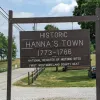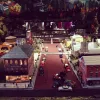Founded in 1849, Waynesburg University (college) has a rich historical tradition. The University is proud to share its history and local history in the Paul R. Stewart Museum, located in the basement of Miller Hall on the main campus.
American & Regional History
The Fourth Avenue Historic District is 'the historic core of Pittsburgh's downtown financial district'.The architectural significance of the district is demonstrated by the architectural richness of the predominantly Classical Revival buildings that were built in the boundary increase area within
Soldiers & Sailors Memorial Hall and Military History Museum stand as a tribute to Pennsylvania's servicemen and servicewomen whose bravery has safeguarded the freedoms we enjoy.
Scandia Community Center and Museum, managed by the Elk Township Historical Society, is a historic one-room school with artifacts and old photos of their education and rural life.
Today Pitt is an internationally recognized center of learning and research, strong in the arts and sciences and the professions. Pitt serves approximately 34,000 students, including 10,000 graduate students in the 17 schools of the Pittsburgh campus.
The Carnegie Free Library is an impressive two-story structure centrally locat at 1301-7th Avenue in Beaver Falls, Pennsylvania. The Building, situated in a strategic corner lot, was designed in the neoclassical or Palladian tradition.
Founded in 1773, Hanna's Town was named for its originator, Robert Hanna. It was the foremost County Seat of Westmoreland County and the site of the first English court west of the Allegheny Mountains.
With a permanent collection of over 750 items, the Antiochian Heritage Museum offers visitors a fascinating glimpse into the textiles, inlaid woodwork, metal crafts, jewelry, and religious art of the Near East.
The Story of Fort Roberdeau In the spring of 1778, the struggle for independence appeared to be over. The British occupied the rebel's capital city, Philadelphia. George Washington's army was destitute at Valley Forge.
Fort Mason Museum allows visitors to experience life in early twentieth-century Fayette County. It features exhibits of local industries, a turn-of-the-century physician's office, typical home life, and a hands-on early school room.
The Johnstown Flood Museum is about one of the most shocking episodes of American history. On May 31, 1889, a neglected dam and a phenomenal storm led to a catastrophe in which 2,209 people died. The Johnstown Area Heritage Association receives many inquiries about the 1889 flood.
Visions of the past come alive at the Rebecca Hadden Stone House Museum. Locally donated and shared artifacts from the mid-19th century to the early 20th century adorn the rooms, and a beautifully maintained herb and perennial garden graces the grounds.
The present building, "Coates House," was made possible in part by a state grant administered through the Pennsylvania Historical and Museum Commission, as well as other grants and funds raised by the Society.
The Robinson Museum (located directly behind Center House) was made possible through a bequest by Florence Himes-Robinson and is the official Museum of Elk County.
The A-K Valley Heritage Museum is located on the corner of Lock Street and East Seventh Avenue in Tarentum.
During the 1892 labor strike, which pitted Carnegie Steel Company against the Amalgamated Association of Iron and Steel Workers, the Bost Building served as the union's local headquarters and as the base for American and British newspaper correspondents reporting on the event.
The Jefferson County History Center relocated to the newly preserved N. G. Edelblute Building (1855-1875) on Historic Brookville's Main Street in March 2004, marking the Bicentennial Year of the county's founding.
Fort Roberdeau Historic Site and Natural Area includes an 1858 barn containing exhibits and a museum shop, an education center in an 1860 farmhouse, three nature trails, picnic facilities, and White Oak Hall, a large multipurpose facility.
Taylor Memorial Museum houses a vast display of glass from local industry, plus many interesting artifacts from the lumbering, mining, and farming communities in the surrounding area.
The building stands near the center of Sharpsville's commercial district, on the east side of a block once dominated by the magnificent 30-room Pierce Mansion. That brick Second Empire-style mansion, completed in 1875, was razed in 1952, and public housing was built in its place.
The historic Flatiron Building, constructed around 1830 along the National Road, was initially built for commercial use. Its distinctive wedge-shaped design—resembling a traditional clothing iron—has made it a prominent landmark in the Brownsville.
1910 was a prosperous year for Franklin and included the building of the National Guard Armory overlooking French Creek.
The Wilder Museum boasts a collection of historical artifacts that will fascinate any visitor.























